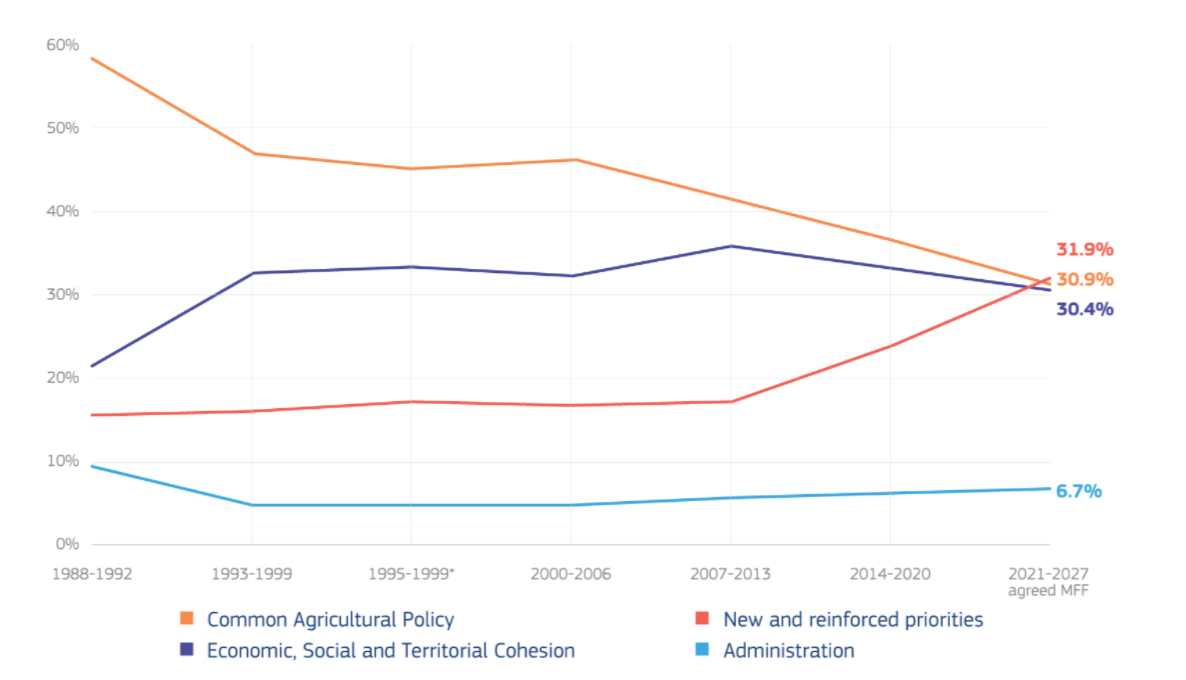The Multiannual Financial Framework - policy up close
by Erik Schmidt-Bergemann, 5 minutes
Every seven years the member states of the European Union come together and decide on the new multiannual financial framework or the budget of the European Union (EU). The last budget ran out at the end of 2020, in the middle of the Covid-19 pandemic, and member states had to come together and negotiate the new framework for the 2021-2027 budget period. This article will cover the new budget in detail and will offer a short explanation of the budget in general.
What is the multiannual financial framework?
The so-called multiannual financial framework (or short MFF) has been used in the EU since 1988. The MFF usually runs for seven years (the required minimum is five years) and touches upon basically every aspect of the EU. For example, programs such as Erasmus or Horizon Europe are funded by the MFF. The MFF sets a yearly limit on commitments and payments that the EU can make. However, in the case of unforeseen circumstances, such as a sudden crisis, the EU has several financial instruments at its disposal to address these sufficiently.
But who makes the initial proposal of the budget and who are the key players in the decision-making process? The Commission starts the process of passing the budget by presenting an initial proposal. This initial proposal will then move on to the Council which may change the proposal by the Commission. Thus, the member states play a central role in the budget decision-making process and can influence the budget. After the Council is done with changing the proposal from the Commission, the budget moves on to the European Parliament. However, it cannot make any official changes to the proposal at this stage since it is not a co-legislator but rather is only asked for consent since the MFF is following the consent procedure. Thus, the Parliament needs to inofficially influence the budget while the EU member states are negotiating it in the Council. After the European Parliament has given its consent to the budget, the Council needs to adopt the budget through a unanimous vote. The legal basis for this is article 312 in the TFEU.
The new budget 2021-2027
Figure 1: European Commission The 2021-2027 MFF
In 2020 the member states had to pass the new budget for the period of 2021-2027. The new budget will encompass €1.211 trillion which are combined with €806.9 billion in the recovery package. The recovery package is what makes this MFF particularly interesting. Due to the unprecedented Covid-19 crisis and its impact on the European economy, the member states have decided to set up a recovery package to limit the negative effects of the Covid-19 crisis on European economies and help the states that have been hit the hardest by the pandemic. The influence of the pandemic on the MFF will be covered in detail below.
The MFF has seen some changes since the first budget was adopted in 1988. Whereas the first three decades had seen a focus on the Common Agricultural Policy and Cohesion Policy, the new budget will shift its focus to new priorities. These new priorities include investments into research and innovation, combating climate change, the transition to the new digital era and the recovery from the Covid-19 pandemic. This exemplifies the new focus on the budget and Figure 2 shows that these new priorities are receiving the largest share in the 2021-2027 MFF. If you want to dive into the details of the new MFF, this brochure by the EU is a good starting point.
Figure 2: European Commission
Another new addition to the 2021-2027 MFF is the so-called “conditionality regulation”. This new regulation has been introduced to address rule of law breaches by member states. An example of a rule of law breach would be if a certain member state does not implement rulings by the Court of Justice. However, this conditionality only applies if “a given member state threaten the EU financial interests” (Source: European Commission). Thus, rule of law breaches that do not threaten the EU’s financial interests are not affected by the new conditionality regulation.
Yet, if a member state should threaten the financial interests of the EU, the Commission is responsible for proposing appropriate measures to the Council to address the breaches by the member state in question. After the Commission has proposed measures to the Council, the Council will make a final decision on the proposal.
The Covid recovery package
Due to the Covid-19 crisis and its huge economic impact on the European economy, the EU has decided to include a recovery package in combination with the new MFF. The main aims of this recovery package are to limit the negative effects of the Covid-19 pandemic and to transform Europe into a digital and sustainable continent. The funds that are allocated under the Recovery and Resilience Facility are directly paid to the member states after the member states have submitted a Recovery and Resilience plan. These plans need to address several challenges including climate change and digitalisation. Once a member state has submitted its plan the Commission will assess it and the European Council will approve it. Once the plan has been approved by the European Council, the member state will receive its allocated funds.
As aforementioned, most of the funds will be used to increase Europe’s digital capabilities and to make European economies ‘green’ and sustainable. Figure 3 showcases several areas that will receive funding under the Recovery and Resilience Facility such as improving digitalisation in public administration or investing in renewable technologies such as solar energy.
Figure 3: European Commission



